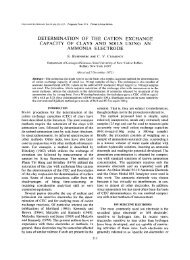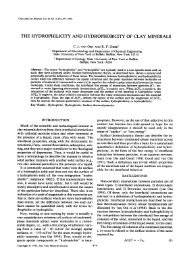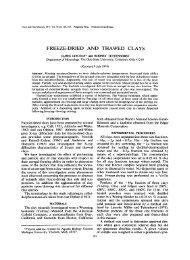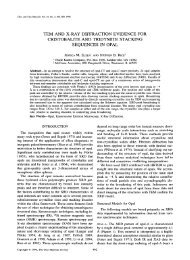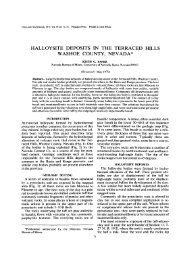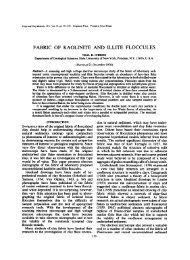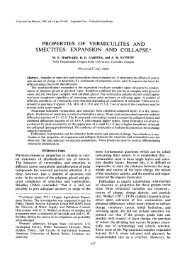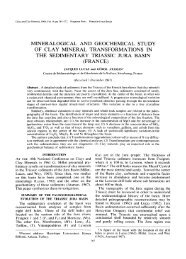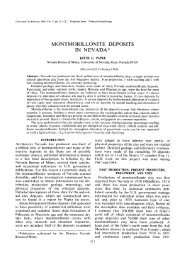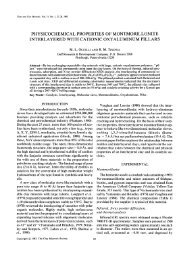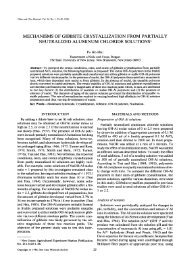formation of halloysite from feldspar: low temperature, artificial ...
formation of halloysite from feldspar: low temperature, artificial ...
formation of halloysite from feldspar: low temperature, artificial ...
Create successful ePaper yourself
Turn your PDF publications into a flip-book with our unique Google optimized e-Paper software.
Clays and Clay Minerals, 1969, Vol. 17, pp. 13-22. Pergamon Press. Printed in G rear Britain<br />
FORMATION OF HALLOYSITE FROM<br />
FELDSPAR: LOW TEMPERATURE, ARTIFICIAL<br />
WEATHERING VERSUS NATURAL WEATHERING<br />
WALTER E. PARHAM<br />
Minnesota Geological Survey. University <strong>of</strong> Minnesota, Minneapolis, Minnesota<br />
(Received 14 October 1968)<br />
Abstract-Weathering products formed on surfaces <strong>of</strong> both potassium and plagioclase f~dspar (ANT0),<br />
which were continuously leached in a Soxhlet extraction apparatus for 140 days with 7-21 <strong>of</strong> distilled<br />
water per day at a <strong>temperature</strong> <strong>of</strong> approximately 78~ are morphologically identical to natural<br />
products developed on potassium <strong>feldspar</strong>s weathered under conditions <strong>of</strong> good drainage in the humid<br />
tropics. The new products, which first appear as tiny bumps on the <strong>feldspar</strong> surface, start to develop<br />
mainly at exposed edges but also at apparently random sites on flat cleavage surfaces. As weathering<br />
continues, the bumps grow outward <strong>from</strong> the <strong>feldspar</strong> surface to form tapered projections, which then<br />
develop into wide-based thin films or sheets. The thin sheets <strong>of</strong> many projections merge laterally to<br />
form one continuous flame-shaped sheet. The sheets formed on potassium <strong>feldspar</strong>s may then roll to<br />
form tubes that are inclined at a high angle to the <strong>feldspar</strong> surface. Etch pits <strong>of</strong> triangular outline on the<br />
<strong>artificial</strong>ly weathered potassium <strong>feldspar</strong>s serve as sites for development <strong>of</strong> continuous, non-rolled,<br />
hol<strong>low</strong> tubes, it is inferred <strong>from</strong> its morphology that this weathering product is <strong>halloysite</strong> or its primitive<br />
form. The product <strong>of</strong> naturally weathered potassium <strong>feldspar</strong>s is <strong>halloysite</strong> - 4H20.<br />
The flame-shaped films or sheets formed on <strong>artificial</strong>ly weathered plagioclase <strong>feldspar</strong> do not<br />
develop into hol<strong>low</strong> tubes, but instead give rise to a platy mineral that is most probably boehmite.<br />
These plates form within the flame-shaped films, and with continued weathering are released as the<br />
film deteriorates. There is no indication <strong>from</strong> this experiment that platy pseudohexagonal kaolinite<br />
tbrms <strong>from</strong> any <strong>of</strong> these minerals under the initial stage <strong>of</strong> weathering.<br />
INTRODUCTION<br />
SOME form <strong>of</strong> the general statement... "Kaolinite<br />
is the clay mineral formed <strong>from</strong> the chemical<br />
weathering <strong>of</strong> potassium <strong>feldspar</strong>". .... is commonly<br />
found in introductory textbooks <strong>of</strong> geology<br />
and frequently in more advanced ones. Examples<br />
in the geological record <strong>of</strong> chemically weathered<br />
rocks <strong>of</strong>ten show that kaolinite is in fact abundant<br />
In a summary <strong>of</strong> the literature on successful<br />
laboratory synthesis <strong>of</strong> kaolinite, Grim (1968)<br />
points out that because most <strong>of</strong> these mineral<br />
identifcations were made by X-ray diffraction<br />
alone and were not made in conjunction with the<br />
electron microscope, there is no certainty that<br />
<strong>halloysite</strong> was not formed also. Other attempts to<br />
synthesize only <strong>halloysite</strong> have been unsuccessful<br />
as an apparent alteration product. However, based on X-ray diffraction analysis (Polzer, 1967;<br />
studies <strong>of</strong> clay mineral products developed or<br />
developing at present <strong>from</strong> chemical weathering <strong>of</strong><br />
various rock types suggest instead that <strong>halloysite</strong><br />
is more commonly the alteration product. Over the<br />
past l0 yr, published studies on various clay minerals<br />
formed as weathering products have increased<br />
substantially in number. In addition, techniques <strong>of</strong><br />
clay mineral identification have steadily improved<br />
and now al<strong>low</strong> more ease and certainty in identifying<br />
and distinguishing platy kaolinite <strong>from</strong> tubular<br />
<strong>halloysite</strong>. Whereas the petrographic microscope,<br />
D.T.A., or chemical analyses were used formerly<br />
as the sole method <strong>of</strong> identification <strong>of</strong> these minerals,<br />
more <strong>of</strong>ten today identification is made with a<br />
variety <strong>of</strong> tools and techniques, which include X-<br />
ray diffraction and electron microscopy. Emphasis<br />
in this study <strong>of</strong> weathering products has been<br />
placed on the use <strong>of</strong> the electron microscope.<br />
Roy and Brindley, 1956; Roy and Osborn, 1952;<br />
and Roy and Osborn, 1954), however De Kimpe<br />
et al. (1964) have synthesized a kaolin mineral that<br />
morphologically is much like <strong>halloysite</strong>. This present<br />
study shows that artifically weathered <strong>feldspar</strong>s<br />
develop the same type <strong>of</strong> alteration products as<br />
are found on naturally weathered <strong>feldspar</strong>s taken<br />
<strong>from</strong> humid tropical environments and, moreover,<br />
that the artifically produced weathering product<br />
may in fact be <strong>halloysite</strong>.<br />
A survey <strong>of</strong> the literature on kaolin clay minerals<br />
formed during recent chemical weathering shows<br />
that <strong>halloysite</strong> is commonly the alteration product<br />
formed <strong>from</strong> parent rocks <strong>of</strong> widely differing compositions<br />
under varying climatic conditions. Other<br />
similar studies <strong>of</strong>ten are not specific as to whether<br />
<strong>halloysite</strong> or kaolinite has formed, and merely<br />
list the presence <strong>of</strong> kandite or kaolinite minerals.<br />
13
. . . Har<br />
14 WALTER E. PARHAM<br />
Localities where <strong>halloysite</strong> has been identified as a<br />
modern weathering product are shown in Fig. 1,<br />
and the authors, geographic areas, and rock types<br />
studied are listed in Table 1. Table 2 is a tabulation<br />
<strong>of</strong> the various analytical techniques used to identify<br />
the clay minerals in each study. Only about 25<br />
et al. (1963) partially agree, but believe that<br />
<strong>halloysite</strong> may form at times without allophane<br />
as the intermediate material.<br />
It seems that there is considerable uncertainty<br />
in our understanding <strong>of</strong> the transition <strong>of</strong> mineral<br />
phases that take place when alumino-silicate<br />
.... ' .... ~ Grant,<br />
Bates, 1962 ~<br />
~./Patt 1e r 1s<br />
~176 9 6<br />
/M ~ Nakamura et al<br />
oberly 1963<br />
Uehara et al 1966<br />
Verguson,<br />
19<br />
196v~ {<br />
63OJ<br />
Simonette et al,<br />
1963 "" @<br />
\~lexander<br />
1943 I<br />
%~m, ant, 1964<br />
et al,<br />
~$; Beaven et al<br />
q ~ 1966<br />
Fairbairn et al 1966<br />
9 v Ostrowicki, 1965<br />
9 Lisitsyna, 1966<br />
t~h~l et al,<br />
%k<br />
~eutelspacher et al 1961 ~ ~ ~ \ 9 / . . . . .<br />
,, , , . - ) x) ~ -- I t3eute,spacher et al, 1961.-~ ~<br />
",', "-4 2' .<br />
\<br />
onct al,<br />
Sudo ct al, 1956<br />
Hosking<br />
1957<br />
Birrell et al, 1955<br />
Fig. 1. Localities <strong>of</strong> studies <strong>of</strong> recent weathering in which <strong>halloysite</strong> has been identified.<br />
per cent <strong>of</strong> these studies listed kaolinite as being<br />
present in the weathering products. Grim (1968)<br />
has commented that "Although the presence <strong>of</strong><br />
<strong>halloysite</strong> in weathering products is well established,<br />
it is a rare component <strong>of</strong> such materials,<br />
and peculiar conditions must be required for its<br />
<strong>formation</strong>."<br />
His view was understandable, as 50 per cent <strong>of</strong><br />
those studies listed in Table 1 are not more than 4<br />
yr old. Keller (1964) noted that "... alumlnous<br />
silicates react with water to give rise.., to .... a<br />
clay mineral."... "Field occurrences show that<br />
the clay mineral formed is commonly either allophane<br />
or <strong>halloysite</strong>..." He further noted that "In<br />
our present stage <strong>of</strong> knowledge, it may be stated<br />
that K-<strong>feldspar</strong> alters to kaolinite via intermediary<br />
mica under certain conditions, but directly to<br />
kaolinite under others, and that it alters to <strong>halloysite</strong><br />
(endellite) via a gel phase, possibly including<br />
transitory allophane." Sudo and Takahashi (1956)<br />
suggested, and Jackson (1959) seems to agree, that<br />
there may be a gradual transition in the products <strong>of</strong><br />
chemical rock weathering <strong>from</strong> allophane to<br />
<strong>halloysite</strong> 9 4HzO to <strong>halloysite</strong>. 2H._,O. Chukrov,<br />
minerals decompose during chemical weathering<br />
to form new products, particularly tubular <strong>halloysite</strong><br />
and platy kaolinite, and that the electron microscope<br />
may be a valuable tool when used to study<br />
the beginnings <strong>of</strong> decomposition <strong>of</strong> one mineral,<br />
i.e. <strong>feldspar</strong>, and the <strong>formation</strong> <strong>of</strong> its alteration<br />
products. Therefore, a study was begun to determine<br />
what surface alteration products form<br />
during natural weathering <strong>of</strong> <strong>feldspar</strong> in the humid<br />
tropics as well as what products form on <strong>feldspar</strong><br />
surfaces under similar conditions in artifical<br />
weathering.<br />
PROCEDURE<br />
The products forming on <strong>feldspar</strong>s in igneous<br />
rocks <strong>from</strong> Hong Kong were selected for the study<br />
<strong>of</strong> natural weathering (Fable 4). Hong Kong, which<br />
adjoins the southernmost point <strong>of</strong> Kwantung<br />
Province, China, lies just within the northern limits<br />
<strong>of</strong> the tropics, has hot humid summers and somewhat<br />
cooler and drier winters, and an average<br />
annual rainfall <strong>of</strong> 85 in. Altitudes ranging <strong>from</strong> sea<br />
level to about 3000ft within the Colony afford<br />
conditions <strong>of</strong> good drainage over much <strong>of</strong> the area.
FORMATION OF HALLOYS1TE FROM FELDSPAR<br />
15<br />
Table 1. Studies on recent rock weathering in which <strong>halloysite</strong> has been identified<br />
Study<br />
number Authors Date Geographic area Parent rock<br />
l Alexander, et al. 1943 Maryland, U.S.A. gabbro, amphibolite<br />
2 Birrell, et al. 1955 New Plymouth, New Zealand volcanic ash<br />
3 Sudo and Takahashi 1956 Japan glassy tuff<br />
4 Hay 1960 St. Vincent, B. W.I. andesitic ash<br />
5 Beutelspacher and van der<br />
Marel 1961 Java, Sumatra, Celebes, Papoealand rhyolite, granite, basalt,<br />
serpentine<br />
6 Bates 1962 Hawaii, U.S.A. basalt<br />
7 Gastuche, et al. 1962 Kivu, Republic <strong>of</strong> the Congo basalt, volcanic ash<br />
8 Robertson 1963 Oregon, U.S.A. tuffor pumice<br />
9 Simonette and Bauleke 1963 North Queensland, Australia basalt<br />
l0 Patterson 1964 Hawaii, U.S.A. basalt<br />
l I Kato 1964-65 Shinshiro City, Japan granodiorite<br />
12 Nakamura and Sherman 1965 Hawaii, U.S.A. basalt<br />
13 Fairbairn and Robertson 1966 Sierra Leone kimberlite<br />
14 Hendricks, et al. 1967 Northeast California, U.S.A. andesite<br />
15 Wolff 1967 Maryland, U.S.A. quartz monzonite<br />
16 Ferguson 1954 Queensland, Australia basalt<br />
17 Weyl 1954 El Salvador dacitic ash<br />
18 Hosking 1957 Australia granite, basalt, sediments<br />
19 Moberly 1963 Hawaii, U.S.A. basalt<br />
20 Grant 1964 Georgia, U.S.A. biotite-plagioclase gneiss<br />
21 Ostrowicki 1965 Poland serpentinite<br />
22 Beaven, and Dumbleton 1966 Trinadad, Jamaica, Grenada,<br />
Barbados, B.W.I.<br />
votcanics, meta-sediments<br />
23 Uehara, et al. 1966 Hawaii, U.S.A. pahoehoe lava<br />
24 Grant 1963 Georgia, U.S.A. granite<br />
25 Lisitsyna 1966 Batumi, U.S.S.R. labradorite-augite porphyry<br />
26 Hardon and Faveje 1939 Java andesitic tuff<br />
27 Kim and Kim 1964 Kyongsang Namdo, Korea anorthosite<br />
The effect <strong>of</strong> climate coupled with conditions <strong>of</strong><br />
good drainage have resulted in deep chemical<br />
weathering <strong>of</strong> a considerable part <strong>of</strong> the predominantly<br />
igneous bedrock. Halloysite .4H20<br />
seems to be the most common clay mineral formed<br />
in the weathering products <strong>of</strong> a variety <strong>of</strong> rock types<br />
in Hong Kong. Clay mineral data on weathering<br />
products <strong>of</strong> this region will be published in another<br />
study.<br />
Soxhlet extraction units (Fig. 2) were used in the<br />
<strong>artificial</strong> weathering <strong>of</strong> a potassium <strong>feldspar</strong><br />
(microcline) and a plagioclase (ANT0) <strong>feldspar</strong><br />
(Table 3). The technique is that first used by<br />
Pedro (1961) in similar leaching studies. Distilled<br />
water in the distilling flask was maintained at its<br />
boiling point by a heating mantle. Condensation<br />
was achieved by the water-cooled condenser at the<br />
top <strong>of</strong> the apparatus <strong>from</strong> where the water fell onto<br />
the <strong>feldspar</strong> be<strong>low</strong>. The water level in the chamber<br />
containing the <strong>feldspar</strong> would rise to the level <strong>of</strong> the<br />
top <strong>of</strong> the siphoning tube and then would drain back<br />
into the distilling flask and the cycle would be<br />
repeated. The <strong>temperature</strong> <strong>of</strong> the water leaching<br />
the <strong>feldspar</strong>s was approximately 77-78~ and the<br />
pH was about 6-5. Approximately 71 <strong>of</strong> water<br />
f<strong>low</strong>ed over each sample per day, and leaching <strong>of</strong><br />
both <strong>feldspar</strong>s was continued for 140 days. The<br />
<strong>feldspar</strong>s were broken into pieces <strong>of</strong> approximately<br />
89 in diameter so that alteration products<br />
that might form could be related to specific cleavage<br />
surfaces.<br />
The <strong>artificial</strong> weathering conditions used in the<br />
laboratory parallel the natural weathering conditions<br />
in Hong Kong, i.e. a hot, humid environment<br />
with high rainfall and good drainage; however, for a<br />
given period <strong>of</strong> time the amount <strong>of</strong> <strong>artificial</strong> rainfall<br />
far exceeds the amount <strong>of</strong> natural rainfall. Pedro<br />
(1961) has pointed out that the absolute humidity<br />
maintained in the Soxhlet apparatus is so high that<br />
the amounts <strong>of</strong> dissolved gases, i.e. oxygen, and<br />
carbon dioxide, are much <strong>low</strong>er in the extractor<br />
than in normal rainfall. In addition, the <strong>temperature</strong><br />
<strong>of</strong> the <strong>artificial</strong> rainfall is considerably above natural<br />
rainfall. Nevertheless, it should be noted that <strong>temperature</strong>s<br />
that have been recorded in the top few<br />
centimeters <strong>of</strong> soils in the humid tropics approach<br />
C.C.M. Vol. 17No. I-B
16 WALTER E. PARHAM<br />
Table 2. Analytical techniques used in the identification <strong>of</strong> <strong>halloysite</strong> for<br />
studies listed in Table 1<br />
Study Electron Petrographic Chemical<br />
number microscope X-ray D.T.A. microscope techniques<br />
l* X X X X<br />
2 X X X<br />
3 X X X<br />
4 X X X<br />
5 X X<br />
6 X X X X<br />
7* X X X X<br />
8 X X X X X<br />
9* X X X X<br />
10 X X X X<br />
11 * X X X X(i.r.) X<br />
12 X X X X X<br />
13" X X X X<br />
14 X X X X<br />
15 X X X<br />
16" X X<br />
17 X X X<br />
18" X X X<br />
19 X<br />
20* X X X<br />
21 X X X X<br />
22 X<br />
23 X X X X<br />
24 X X<br />
25<br />
26 (Identification techniques not known)<br />
? X<br />
27 (Identification techniques not known)<br />
*= Kaolinite present.<br />
i.r. = Infrared.<br />
those used in this <strong>artificial</strong> weathering study. Surface<br />
and very near surface soil temperatues at<br />
Poona, India have reached 75~ and similarly,<br />
<strong>temperature</strong>s in the range <strong>of</strong> 84-86~ have been<br />
recorded in soils <strong>of</strong> the Congo and East Africa<br />
(Mohr, and van Baren, 1954), and 80~ in the<br />
Republic <strong>of</strong> the Sudan (Carlisle, 1968). Although<br />
these soil <strong>temperature</strong>s represent extremes, they<br />
do place the <strong>artificial</strong> <strong>temperature</strong> conditions within<br />
the limits <strong>of</strong> naturally existing ones.<br />
Surface replicas <strong>of</strong> the various cleavage surfaces<br />
<strong>of</strong> the K-<strong>feldspar</strong> and plagioclase <strong>feldspar</strong> were<br />
prepared with replica tape, shadowed with platinum-palladium<br />
and back with a carbon film for<br />
examination with the Phillips 100-B electron<br />
microscope at the end <strong>of</strong> the leaching period. The<br />
replica tape was dissolved with acetone and the<br />
replica was treated with hydr<strong>of</strong>luoric acid for about<br />
15 rain to remove any adhering mineral matter.<br />
ARTIFICIAL AND NATURAL WEATHERING<br />
EFFECTS ON FELDSPAR<br />
A comparison <strong>of</strong> the morphology <strong>of</strong> <strong>artificial</strong>ly<br />
produced weathering products developed on<br />
K-<strong>feldspar</strong> surfaces with those formed naturally<br />
shows both products to be essentially the same.<br />
Moreover, the evolution in the <strong>formation</strong> <strong>of</strong> the<br />
weathering products in both instances is remarkably<br />
similar. The morphology <strong>of</strong> the end product<br />
produced <strong>artificial</strong>ly <strong>from</strong> the weathering <strong>of</strong><br />
K-<strong>feldspar</strong> appears to be the clay mineral <strong>halloysite</strong>,<br />
whereas the mineral formed <strong>from</strong> plagioclase<br />
(ANT0) <strong>feldspar</strong> is most probably boehmite.<br />
Continual percolation <strong>of</strong> hot, distilled water<br />
through each Soxhlet extractor chamber containing<br />
the <strong>feldspar</strong> fragments quickly produced visible<br />
changes in the color <strong>of</strong> the water within the distilling<br />
flask as well as altering the color <strong>of</strong> some surfaces<br />
<strong>of</strong> the <strong>feldspar</strong> fragments themselves. Dissolved<br />
material carried downward into the distilling flask<br />
<strong>from</strong> the plagioclase <strong>feldspar</strong> gave the water a<br />
slightly milky color after 4 days, and with increased<br />
leaching time the milky color became more pronounced.<br />
Water <strong>from</strong> the K-<strong>feldspar</strong>, on the other<br />
hand, developed a slight cloudiness after 14 days<br />
and maintained the same cloudiness to the end <strong>of</strong>
Fig. 2. Soxhlet extraction apparatus for leaching<br />
<strong>feldspar</strong>s with distilled water.<br />
[Facing page 16]
Fig. 3A. Replica <strong>of</strong> naturally weathered K-<strong>feldspar</strong> surface showing initial weathering<br />
products in form <strong>of</strong> small bumps and tapered projections. Joining <strong>of</strong> the lines <strong>of</strong> alteration<br />
products suggest influence <strong>of</strong> crystal dislocation at site <strong>of</strong> <strong>formation</strong>. Sample DWB-3.<br />
Fig. 3B. Replica <strong>of</strong> <strong>artificial</strong>ly weathered K-<strong>feldspar</strong> showing alteration product as line <strong>of</strong><br />
small bumps grading laterally into flame-shaped sheet.
Fig. 4A. Replica <strong>of</strong> a naturally weathered K-<strong>feldspar</strong><br />
surface showing an alteration product developing as<br />
rows <strong>of</strong> overlapping tapered projections. Sample DWB-3.<br />
Fig. 4B. Replica <strong>of</strong> an <strong>artificial</strong>ly weathered K-<strong>feldspar</strong> surface<br />
showing development <strong>of</strong> non-rolled tubes. Line <strong>of</strong> tubes<br />
in right half appears to be based on etch pits like those in<br />
upper half <strong>of</strong> photograph and those in <strong>low</strong>er right quarter.<br />
Tubes are tilted and overlap one another in left half <strong>of</strong><br />
photograph.
Fig. 5A. Replica <strong>of</strong> a naturally weathered K-<strong>feldspar</strong><br />
surface showing rows <strong>of</strong> tapered projections, many with<br />
wide, sheet-like bases. Sample DWB-3.<br />
Fig. 5B. Replica <strong>of</strong> an <strong>artificial</strong>ly weathered K-<strong>feldspar</strong><br />
surface showing tapered projections, some with wide<br />
sheet-like bases. Arrows show tubes formed by rolling<br />
<strong>of</strong> the thin sheets.
J<br />
E<br />
:Z<br />
c~<br />
>-,<br />
c~<br />
e.<br />
0<br />
c~<br />
.o<br />
0<br />
.o<br />
&<br />
c~<br />
&<br />
&<br />
.=_<br />
c~<br />
o<br />
.4
qr<br />
I<br />
Fig. 7A. Transmission electron micrograph <strong>of</strong> a bundle <strong>of</strong> <strong>halloysite</strong> tubes<br />
<strong>from</strong> naturally weathered Hong Kong granite.<br />
Fig. 7B. Replica <strong>of</strong> an <strong>artificial</strong>ly weathered K-<strong>feldspar</strong> surface showing a bundle<br />
<strong>of</strong> tube-like, alteration products, perhaps <strong>halloysite</strong>.
....<br />
i<br />
Fig, 8. Replica <strong>of</strong> an <strong>artificial</strong>ly weathered plagioclase (ANT0)<br />
<strong>feldspar</strong> surface showing a well-developed, flame-shaped<br />
sheet with tapered projections as terminations.<br />
Fig. 9. Replica <strong>of</strong> an <strong>artificial</strong>ly weathered plagioclase (An:0)<br />
<strong>feldspar</strong> surface showing regularly formed, geometric plates,<br />
most probably boehmite.
Fig. 10. Replica <strong>of</strong> saddle portion <strong>of</strong> a flame-shaped sheet formed <strong>from</strong><br />
<strong>artificial</strong> weathering <strong>of</strong> plagioclase (ANT0) <strong>feldspar</strong>. Note initial<br />
development <strong>of</strong> plates <strong>of</strong> regularly formed, geometric outline within<br />
sheet material and well-formed, smaller plates be<strong>low</strong> similar to those <strong>of</strong><br />
Fig. 9. Plates forming are most probably boehmite.
FORMATION OF HALLOYSITE FROM FELDSPAR 17<br />
Table 3. Typical chemical analyses for <strong>feldspar</strong>s used for<br />
this <strong>artificial</strong> weathering study<br />
K-<strong>feldspar</strong> (microcline) <strong>from</strong> mine at Casper Mt., Casper,<br />
Wyoming. Chemical analysis obtained <strong>from</strong> F. F. Miller<br />
<strong>of</strong> International Minerals and Chemical Corporation,<br />
Custer, South Dakota.<br />
SIO 2 64.4%<br />
A1203 19.6<br />
Fe203 0.04<br />
CaO 0.1<br />
Na~O 3.0<br />
KzO 12-6<br />
Ign. 0.2<br />
99-94%<br />
Plagioclase <strong>feldspar</strong> (An7o) <strong>from</strong> anorthosite outcrop<br />
along shore at Silver Bay, Minnesota, SEI/4 NE1/4<br />
sec. 6, T. 55 N., R. 7 W. Sample number M-3190.<br />
SiOz 47.25%<br />
A1203 31 "56<br />
FeO 2.29<br />
CaO 15-39<br />
Na20 2.52<br />
K20 0-37<br />
MgO 0.27<br />
H20+]<br />
H20-~ 0.40<br />
100-05%<br />
Table 4. Localities <strong>of</strong> naturally weathered K-<strong>feldspar</strong><br />
samples<br />
DW B - 1<br />
DWB-3<br />
Orthoclase <strong>from</strong> syenite; surface <strong>of</strong> crystals<br />
weathered to depth <strong>of</strong> 1-2 mm; Mesozoic in<br />
age; roadcut in fresh syenite 1/4 mile SW <strong>of</strong><br />
Wong Nai Chung Gap along Deep Water<br />
Bay Road, Hong Kong Island, Hong Kong,<br />
B.C.C., 114 ~ 10' 20" E., 22 ~ 15' 30" N.<br />
Orthoclase <strong>from</strong> Hong Kong granite, partially<br />
weathered, slightly bleached, dull pale<br />
pink color; Upper Jurassic in age. Same<br />
locality as DWB-I.<br />
the leaching experiment. A small portion <strong>of</strong> the<br />
milky liquid was removed <strong>from</strong> the plagioclase<br />
<strong>feldspar</strong> distilling flask after 119 days, dried and<br />
X-rayed. The material was amorphous to X-ray.<br />
A rust-red discoloration appeared after 29 days<br />
on the (100) cleavage surface <strong>of</strong> the K-<strong>feldspar</strong><br />
fragments in the uppermost zone <strong>of</strong> the chamber,<br />
i.e. the most well drained and aerated part <strong>of</strong> the<br />
leaching column. Electron microprobe analysis<br />
showed that the discoloration was caused by a very<br />
small amount <strong>of</strong> iron on those surfaces. It seems<br />
that during the <strong>artificial</strong> weathering sufficient iron<br />
was able to migrate to the (100) cleavage surface<br />
<strong>of</strong> this K-<strong>feldspar</strong> to produce visible iron oxide<br />
stain, and that the staining <strong>of</strong> only one surface<br />
resulted <strong>from</strong> a differential rate <strong>of</strong> weathering with<br />
respect to the major cleavage surfaces. A white<br />
alteration product formed on the (001) and (010)<br />
cleavage surfaces but no iron oxide stain appeared<br />
here.<br />
Surface alteration on the plagioclase <strong>feldspar</strong><br />
was observed as a pale pink discoloration after<br />
112 days <strong>of</strong> leaching. The pink alteration product<br />
was not restricted to a specific cleavage surface,<br />
as was the case for the K-<strong>feldspar</strong>, but instead<br />
seemed to form as coatings at random sites on all<br />
surfaces.<br />
Electron micrographs in Figs. 3 through 7B display<br />
the most commonly observed forms <strong>of</strong> surface<br />
alteration products formed on naturally and<br />
<strong>artificial</strong>ly weathered K-<strong>feldspar</strong>s. Figures 3A and<br />
3 B show the first stage in the natural and <strong>artificial</strong><br />
weathering <strong>of</strong> K-<strong>feldspar</strong>. The first alteration product<br />
to form on the mineral's surface appears as<br />
lines <strong>of</strong> tiny bumps, as small as 0.01 tz in diameter.<br />
This initial product and all those described subsequently<br />
form at a variety <strong>of</strong> sites on <strong>feldspar</strong><br />
surfaces. Formation <strong>of</strong> these products may take<br />
place along apparent crystal dislocations (Fig. 3A),<br />
at the intersection <strong>of</strong> cleavage planes, along etch<br />
pits, on any irregularity on the mineral's surface,<br />
and at apparently random sites on flat surfaces.<br />
The morphology <strong>of</strong> the alteration products is the<br />
same on all <strong>feldspar</strong> surfaces examined. The tiny<br />
bumps grow outward <strong>from</strong> the <strong>feldspar</strong> surface to<br />
form tapered projections (Fig. 3A) which may<br />
attain a micron in length. It is not evident in most<br />
instances whether the tapered projections are<br />
hol<strong>low</strong> or solid, though it seems that many are<br />
hol<strong>low</strong>. Figure 4B shows hol<strong>low</strong> tubes rising<br />
upward <strong>from</strong> the <strong>artificial</strong>ly weathered K-<strong>feldspar</strong><br />
<strong>from</strong> bases that outline etch pits. Lengthening <strong>of</strong><br />
the tubes is <strong>of</strong>ten accompanied by a tendency for<br />
them to tilt and overlap one another (Figs. 4A<br />
and 4B).<br />
As the tapered projections continue to grow,<br />
they develop wide bases that are more sheet-like<br />
than tube-like in form (Figs. 5A and 5B). As the<br />
bases widen they coalesce to form a continuous<br />
flame-shaped film or sheet (Figs. 6A and 6B).<br />
Segments <strong>of</strong> the flame-shaped sheet may roll to<br />
form tubes that are inclined at a high angle to the<br />
<strong>feldspar</strong> surface (Fig. 5B, arrows). Thus it appears<br />
that the form <strong>of</strong> the alteration product may be either<br />
as rolled tubes (Fig. 5B, arrows) or as non-rolled<br />
hol<strong>low</strong> tubes (Fig. 4B).<br />
Figure 7A shows a bundle <strong>of</strong> <strong>halloysite</strong> tubes
18 WALTER E. PARHAM<br />
formed under natural weathering conditions <strong>from</strong><br />
the Hong Kong granite, taken <strong>from</strong> a suspension <strong>of</strong><br />
the clay fraction and mounted on a Formvarcovered<br />
electron microscope grid. This mineral<br />
was identified as <strong>halloysite</strong> - 4H20 by X-ray diffraction.<br />
Figure 7B similarly shows a bundle <strong>of</strong> tubes<br />
formed during the <strong>artificial</strong> weathering <strong>of</strong> K-<br />
<strong>feldspar</strong>. This alteration product has not been<br />
identified by X-ray because <strong>of</strong> the small amount<br />
present. Nevertheless, <strong>from</strong> the general form <strong>of</strong> the<br />
bundle <strong>of</strong> tubes the alteration product is inferred<br />
to be <strong>halloysite</strong> or its primitive form.<br />
The outer weathered surfaces <strong>of</strong> orthoclase<br />
crystals in syenite (sample DWB-I), exposed in a<br />
near vertical face along a road cut through fresh<br />
rock, show the same form <strong>of</strong> alteration products as<br />
the other K-<strong>feldspar</strong>s. The syenite rock surface<br />
was bare <strong>of</strong> soil and plant material where the<br />
<strong>feldspar</strong>s were sampled. The south-facing cut was<br />
exposed to the sun and subject to rainfall and<br />
surface rainwash. The obvious depth <strong>of</strong> weathering<br />
penetrated only 1-2 mm into the exposed <strong>feldspar</strong>s.<br />
Although the roadcut is slightly less than 5 yr old,<br />
the various forms <strong>of</strong> weathering products described<br />
thus far are already well developed here. It would<br />
be interesting to know the minimum time needed<br />
for <strong>formation</strong> <strong>of</strong> similar surface alteration products<br />
in the tropics and in <strong>temperature</strong> areas as well.<br />
Artificial weathering products formed on the<br />
plagioclase <strong>feldspar</strong> developed into much the same<br />
forms as those on K-<strong>feldspar</strong>. Long flame-shaped<br />
sheets formed on the plagioclase <strong>feldspar</strong> (Fig. 8),<br />
but no hol<strong>low</strong> tubes nor well defined rolled tubes<br />
were seen. Although this sample <strong>of</strong> plagioclase<br />
<strong>feldspar</strong> has an unweathered appearance in hand<br />
specimen, it was noted in replicas <strong>of</strong> cleavage<br />
surfaces prior to leaching that trace amounts <strong>of</strong><br />
flame-shaped sheets were already present and that<br />
scattered tiny bumps could be seen in small areas.<br />
After the leaching period, there was a pronounced<br />
increase in the amount <strong>of</strong> flame-shaped sheet<br />
material covering the <strong>feldspar</strong>'s surface. Moreover,<br />
there was now one additional product not<br />
present at the start. Scattered over the plagioclase<br />
<strong>feldspar</strong> surfaces were areas containing prominent<br />
flakes <strong>of</strong> regular geometric form (Fig. 9), the diameters<br />
<strong>of</strong> which range <strong>from</strong> 0.25 to 1.25/x. X-ray<br />
diffraction data shows the mineral to be most<br />
probably boehmite (Fable 5). An <strong>artificial</strong> weathering<br />
study on kaolinite by Pedro and Berrier (1966)<br />
using a Soxhlet apparatus, showed by X-ray<br />
diffraction that kaolinite was partially converted to<br />
boehmite and not gibbsite after prolonged leaching.<br />
Based on conditions <strong>of</strong> minimal <strong>temperature</strong> and<br />
pressure under which boehmite could form<br />
(Kennedy, 1959) and on the X-ray reflections <strong>from</strong><br />
the <strong>artificial</strong>ly weathered <strong>feldspar</strong> it would seem<br />
likely that the regularly shaped platy weathering<br />
Table 5. X-ray reflections for plagioclase <strong>feldspar</strong> (ANT0) before and after<br />
107 days <strong>of</strong> <strong>artificial</strong> weathering, and newly developed reflections <strong>of</strong><br />
boehmite<br />
Fresh <strong>feldspar</strong> Weathered <strong>feldspar</strong> Weathering product-boehmite<br />
hklandlest, lest. ,~ hklandlest.<br />
6-56 1]0 in w<br />
4-69 021 w w<br />
4-04 20]- m m<br />
3.92 111 w w<br />
3.77 130 m m<br />
3.65 131 m w<br />
3-47 l12w w<br />
3.38 ll2m m<br />
3.26 (?) m w<br />
3.20 040 s s<br />
3.17 002 s s<br />
3-14 220 s w(?)<br />
3.05 131 w w<br />
2-94 041 m w<br />
2.84 131 m w<br />
2.52 241, 1T2 m w<br />
2-39 310, 150 m<br />
2.23 244 rn w<br />
6.11 020rn<br />
2-35 041,130 w<br />
Estimated intensity (! est.) <strong>of</strong> X-ray reflections, s= strong, m=<br />
medium, w = weak.
FORMATION OF HALLOYS1TE FROM FELDSPAR 19<br />
product formed on the plagioclase <strong>feldspar</strong><br />
surface is boehmite.<br />
The boehmite crystals form within the flameshaped<br />
sheets (Fig. 10), <strong>from</strong> which they are<br />
ultimately released. Considering the somewhat<br />
ragged outline <strong>of</strong> flakes within the sheet in Fig. 10,<br />
it might seem that they undergo some further<br />
growth after their release. No naturally weathered<br />
plagioclase (An70) <strong>feldspar</strong>s have yet been studied<br />
for comparison purposes.<br />
DISCUSSION<br />
Comparison in this study <strong>of</strong> <strong>artificial</strong>ly and<br />
naturally produced surface weathering products<br />
on <strong>feldspar</strong>s suggests that the products, whether<br />
formed in an <strong>artificial</strong> or natural weathering environment,<br />
evolve in a similar way. Further, <strong>halloysite</strong><br />
and boehmite seem to be the new mineral phases<br />
produced under these <strong>artificial</strong> weathering conditions<br />
and that their <strong>formation</strong> is in part related<br />
to the chemical composition <strong>of</strong> the parent <strong>feldspar</strong>s.<br />
What the detailed nature <strong>of</strong> the transition<br />
phases that exist between unaltered <strong>feldspar</strong> and<br />
either <strong>halloysite</strong> or boehmite are, is not known<br />
at present. Speculation based on their morphological<br />
aspects and <strong>from</strong> the literature suggest that<br />
these intermediate forms might be classed as allophane.<br />
The composition <strong>of</strong> the flame-shaped sheets<br />
shown in Figs. 6A, 6B, 8, and l0 is not known.<br />
Published electron micrographs <strong>of</strong> allophane<br />
(Beutelspacher and van der Marel, 1968), (Grim,<br />
1968) are dissimilar to the flame-shaped sheets<br />
and other weathering products formed on either<br />
<strong>feldspar</strong> type. On the other hand, Yoshinaga<br />
et a/.(1968) have shown electron micrographs <strong>of</strong><br />
soil allophane exhibiting a certain degree <strong>of</strong> structural<br />
order that corresponds in form to the tapered<br />
projections formed on both <strong>artificial</strong>ly weathered<br />
<strong>feldspar</strong>s. Perhaps, as suggested by Sudo and<br />
Takahashi (1956), Jackson (1959), and Keller<br />
(1964), during rock weathering minerals such as<br />
<strong>feldspar</strong> alter first to allophane and then to <strong>halloysite</strong>.4H20.<br />
The results <strong>of</strong> leaching experiments<br />
similar to this one (Pedro, and Berrier, 1966;<br />
Pickering, 1962) suggest that the flame-shaped<br />
sheets formed on the K-<strong>feldspar</strong> would have a<br />
chemical composition approximating allophane or<br />
<strong>halloysite</strong>.<br />
Low <strong>temperature</strong> studies on the alteration <strong>of</strong> K-<br />
<strong>feldspar</strong> in solutions <strong>of</strong> varied pH (Wollast, 1967)<br />
indicate that kaolinite will form only if the leaching<br />
solutions contain silica in excess <strong>of</strong> about 5 ppm.<br />
It is assumed that this concentration <strong>of</strong> silica would<br />
be necessary also for the <strong>formation</strong> <strong>of</strong> <strong>halloysite</strong>.<br />
When the silica content falls be<strong>low</strong> this level (about<br />
5 ppm), <strong>formation</strong> <strong>of</strong> various hydrous aluminum<br />
oxides should take place instead. Pickering (1962)<br />
speculated that "In well-drained soils in areas <strong>of</strong><br />
high rainfall the groundwater is probably undersaturated<br />
with many <strong>of</strong> the chemical products<br />
<strong>of</strong> weathering." This <strong>artificial</strong> weathering study<br />
simulated conditions <strong>of</strong> good drainage in combination<br />
with high rainfall. It is likely that the solutions<br />
leaching the plagioclase <strong>feldspar</strong> may be undersaturated<br />
with respect to silica, thus inhibiting<br />
<strong>formation</strong> <strong>of</strong> <strong>halloysite</strong> but instead favoring<br />
<strong>formation</strong> <strong>of</strong> boehmite. The SiOJAl203 ratio for<br />
the original plagioclase (ANT0) <strong>feldspar</strong> was l-5/1,<br />
whereas the ratio in the K-<strong>feldspar</strong> was 3"3/1.<br />
The variation in silica content <strong>of</strong> the two <strong>feldspar</strong>s<br />
coupled with their different end products <strong>of</strong> weathering<br />
also suggests that the K-<strong>feldspar</strong> silica content<br />
is sufficiently high to maintain a silica concentration<br />
in the leaching solution above Wollast's<br />
(1967) figure <strong>of</strong> about 5 ppm, and thus al<strong>low</strong><br />
hailoysite to form as the stable alteration product<br />
whereas at the same time <strong>halloysite</strong> would not<br />
form <strong>from</strong> the plagioclase (ANT0) <strong>feldspar</strong>.<br />
Pickering's (1962) experiments further indicated<br />
that within the normal natural weathering <strong>temperature</strong><br />
range <strong>of</strong> 0-35~ dissolution reactions in<br />
silicate rocks are essentially the same, indicating<br />
to him that chemical weathering processes are no<br />
different in the tropics than in cooler climates.<br />
The warmer <strong>temperature</strong>s <strong>of</strong> the tropics would<br />
have the effect merely <strong>of</strong> speeding up the dissolution<br />
process. Replicas <strong>of</strong> surface alteration<br />
products formed <strong>from</strong> <strong>feldspar</strong>s weathered under<br />
varied climatic conditions have as yet not been<br />
examined with the electron microscope. Such<br />
in<strong>formation</strong> is needed for correlation with the<br />
results <strong>of</strong> Picketing (1962) and Wollast (1967).<br />
Occurrences <strong>of</strong> <strong>halloysite</strong> in weathered materials<br />
within the geologic column seem to be less common<br />
with increasing age. The common occurence <strong>of</strong><br />
<strong>halloysite</strong> in modern weathering products suggests<br />
that the element <strong>of</strong> time is related to the presence<br />
<strong>of</strong> <strong>halloysite</strong> and that <strong>halloysite</strong> may change s<strong>low</strong>ly<br />
with time to kaolinite. However, well preserved<br />
tubular <strong>halloysite</strong> is found with platy kaolinite in<br />
a weathered residuum <strong>of</strong> Jurassic or Cretaceous<br />
age developed <strong>from</strong> Precambrian granite-gneisses<br />
in Minnesota. In this case, at least, <strong>halloysite</strong> has<br />
been stable for a considerable period <strong>of</strong> geologic<br />
time. Moreover, kaolinite has <strong>of</strong>ten been reported<br />
in modern weathering products as well, further<br />
complicating understanding <strong>of</strong> the geologic relationship<br />
between the two minerals.<br />
It seems however that certain <strong>of</strong> these problem<br />
areas can be eliminated with similar <strong>artificial</strong><br />
weathering studies and with further examination<br />
<strong>of</strong> the weathering products with the electron<br />
microscope. The apparent latitude that exists in
20 WALTER E. PARHAM<br />
establishing an <strong>artificial</strong> weathering environment<br />
that will produce like alteration forms to those<br />
formed naturally, coupled with a highly accelerated<br />
weathering rate <strong>of</strong>fers a tool for removing the factor<br />
<strong>of</strong> geologic time <strong>from</strong> the study <strong>of</strong> certain aspects<br />
<strong>of</strong> rock weathering.<br />
Acknowledgments-The author wishes to acknowledge<br />
the partial support <strong>of</strong> this study by both the Graduate<br />
School and the Office <strong>of</strong> International Programs, University<br />
<strong>of</strong> Minnesota. P. W. Weiblen <strong>of</strong> the Department <strong>of</strong><br />
Geology and Geophysics, University <strong>of</strong> Minnesota,<br />
identified an iron coating on the <strong>artificial</strong>ly weathered<br />
K-<strong>feldspar</strong> with an electron microprobe.<br />
REFERENCES<br />
Alexander, L. T., Faust, G. T., Hendricks, S. B., lnsley,<br />
H., and McMurdie, H. F. (1943) Relationship <strong>of</strong> the<br />
clay minerals <strong>halloysite</strong> and endellite: Am. Mineralogist<br />
28, 1-18.<br />
Bates, T. F. (1962) Halloysite and gibbsite <strong>formation</strong><br />
in Hawaii: Clays and Clay Minerals 9, 315-328.<br />
Beaven, P. J., and Dumbleton, M. J. (1966) Clay minerals<br />
and geomorphology in four Caribbean islands: Clay<br />
Minerals 6, 371-382.<br />
Beutelspacher, H., and van der Marel, H. W. (1961)<br />
Kennzeichen zur ldentifizierung von Kaolinit, 'Fire<br />
clay' mineral und Haltoysit, ihre Verbreitung und<br />
Bildung: Tonid. Ztg. Keram. Rundschau 85, 517-525,<br />
570-582.<br />
Beutelspacher, H., and van der Marel, H. W. (1968)<br />
Atlas <strong>of</strong> electron microscopy <strong>of</strong> clay minerals and<br />
their admixtures: Elsevier, New York, 333 pp.<br />
Birrell, K. S., Fieldes, M., and Williamson, K. 1. (1955)<br />
Unusual forms <strong>of</strong> <strong>halloysite</strong>: Am. Mineralogist 40,<br />
122-124.<br />
Carlisle, D. B. (1968) Triops (Entomostraca) eggs killed<br />
only by boiling: Science 161,279-280.<br />
Chukrov, F. V., Verkhin, S. I., Ermilova, L. P., Moleva,<br />
V. A., and Rudnitskaya, E. S. (1963) Allophanes <strong>from</strong><br />
some deposits <strong>of</strong> the U.S.S.R.: Intern. Clay Conf. 2,<br />
19-28.<br />
DeKimpe, C., Gastuche, M. C., and Brindley, G. W.<br />
(1964) Low-<strong>temperature</strong> syntheses <strong>of</strong> kaolin minerals:<br />
Am. Mineralogist 49, 1 - 16.<br />
Fairbairn, P. E., and Robertson, R. H. S. (1966) Stages<br />
in the tropical weathering <strong>of</strong> kimberlite: Clay Minerals<br />
6, 351-370.<br />
Ferguson, J. A. (1954) Trans<strong>formation</strong>s <strong>of</strong> clay minerals<br />
in black earths and red loams <strong>of</strong> basaltic origin:<br />
Australian J. Agri. Res. 5, 98-108.<br />
Gastuche, M. C., and DeKimpe, C. (1962) La gen~se<br />
des min&aux agrileux de la famille du kaolin; I 1 Aspect<br />
Cristallin; Gen~se et syntheses des argiles: Editions<br />
du Centre Nat. Rech. Sci. Paris, 67-81. (Summarizes<br />
work <strong>of</strong> colleagues A. Prcrot, J. Delvigne, and J. Fripiat).<br />
Grant, W. H. (1963) Weathering <strong>of</strong> Stone Mountain<br />
Granite: Clays and Clay Minerals 11, 65-73.<br />
Grant, W. H. (1964) Chemical weathering <strong>of</strong> biotiteplagioclase<br />
gneiss: Clays and Clay Minerals 12,<br />
455-463.<br />
Grim, R. E. (1968) Clay Mineralogy: McGraw-Hill,<br />
New York 596 pp.<br />
Hardon, H. J., and Faveje, J. Ch. L. (1939) Mineralogische<br />
Onderzoekingen aan kleien en Kleimineralen:<br />
Mededeel. Landbonwhoogeschool Wageningen 43, 6.<br />
Hay, R. L. (1960) Rate <strong>of</strong> clay <strong>formation</strong> and mineral<br />
alteration in a 4000-year-old volcanic ash soil on<br />
St. Vincent, B. W. 1.: Am.J. Sci. 258, 354-368.<br />
Hendricks, D. M., Whittig, L. D., and Jackson, M. L.<br />
(1967) Clay mineralogy <strong>of</strong> andesite saprolite: Clays<br />
and Clay Minerals 15, 395-407.<br />
Hosking, J. S. (1957) Clay mineralogy and parent material:<br />
2nd Australian Conf. SoiI Sci. 1, 8 pp.<br />
Jackson, M. L. (1959) Frequency distribution <strong>of</strong> clay<br />
minerals in major great soil groups as related to the<br />
factors <strong>of</strong> soil <strong>formation</strong>: Clays and Clay Minerals<br />
6, 133-143.<br />
Kato, I. (1964-65). Mineralogical study <strong>of</strong> weathering<br />
products <strong>of</strong> granodiorite at Shinshiro City: (Parts I-V 1 ):<br />
Soil Sci. Plant Nutr. 10, 258-269; 11, 30-40, 16-27,<br />
16-30.<br />
Keller, W. D. (1964) Processes <strong>of</strong> origin and alteration<br />
<strong>of</strong> clay minerals: In Soil clay mineralogy, Edited by<br />
Rich, C. I., and Kunze, G. W., 3-76.<br />
Kennedy, G. C. (1959) Phase relations in the system<br />
A1203-H20 at high <strong>temperature</strong>s and pressures:<br />
Am. J. Sci. 257, 563-573.<br />
Kim, J. H., and Kim, D. H. (1964) Investigative report <strong>of</strong><br />
the San Chong and Tan Song <strong>halloysite</strong> deposits,<br />
San Chong Gun, Kyongsang Namdo, Korea: Korea<br />
Geol. Surv. Bull. 7, 67-88.<br />
Lisitsyna, N. A. (1966) Genesis <strong>of</strong> gibbsite in slightly<br />
altered rocks <strong>of</strong> the residuum: Dokl. Akad. Nauk.<br />
SSSR 168, 162-164.<br />
Moberly, Jr., R. (1963) Amorphous marine muds <strong>from</strong><br />
tropically weathered basalts: Am. J. Sci. 261,767-772.<br />
Mohr, E. C. J., and van Baren, F. A. (1954) Tropical<br />
soils: lnterscience, New York, 498 pp.<br />
Nakamura, M. T., and Sherman, G. D. (1965) The<br />
genesis <strong>of</strong> <strong>halloysite</strong> and gibbsite <strong>from</strong> mugearite on<br />
the island <strong>of</strong> Maui: Hawaii Agr. Exp. S. Tech. Bull.<br />
62, 36 pp.<br />
Ostrowicki, B. (1965) Minerals <strong>of</strong> the <strong>halloysite</strong> group<br />
<strong>from</strong> Szklary (Lower Silesia): Bull. L'Acad. Polon.<br />
Sci. 13, 29-34.<br />
Patterson, S. H. (1964) Halloysitic underclay and amorphous<br />
inorganic matter in Hawaii: Clays and Clay<br />
Minerals 12, 153-172.<br />
Pedro, G. (1961) An experimental study <strong>of</strong> the geochemical<br />
weathering <strong>of</strong> crystalline rocks by water:<br />
Clay Minerals Bull. 4, 266-281.<br />
Pedro, G., and Berrier, J. C. R. (1966) Sur l'alteration<br />
exprrimentale de la kaolinite et sa trans<strong>formation</strong> en<br />
boehmite par lessivage ~ l'eau: Acad. Sci. Paris 262,<br />
Series D, 729-732.<br />
Picketing, R. J. (1962) 1. Some leaching experiments<br />
on three quartz-free silicate rocks and their contribution<br />
to an understanding <strong>of</strong> lateralization: Econ. Geol.<br />
57, 1185-1206.<br />
Polzer, W. L., Hem, J. D., and Gabe, H. J. (1967)<br />
Formation <strong>of</strong> crystalline hydrous aluminosilicates<br />
in aqueous solutions at room <strong>temperature</strong>: U. S. Geol.<br />
Surv. Pr<strong>of</strong>. Paper 575-B, B 128-132.
FORMATION OF HALLOYS1TE FROM FELDSPAR 21<br />
Robertson, R. H. S. (1963) Allophanic soil <strong>from</strong> Trail<br />
Bridge, Oregon, with notes on mosaic growth in clay<br />
minerals: Clay Minerals Bull. 5, 237-247.<br />
Roy, R., and Brindley, G. (1956) A study <strong>of</strong> the hydrothermal<br />
reconstitution <strong>of</strong> the kaolin clays: Clays and<br />
Clay Minerals 4, 125-132.<br />
Roy, R., and Osborn, E. F. (1952) Studies in the system<br />
alumina-silica-water: in Problems <strong>of</strong> clay and laterite<br />
genesis: A.I.M.M.E. (New York) 76-80.<br />
Roy, R., and Osborn, E. F. (1954) The system AI20.~-<br />
SiO~-H~O: Am. Mineralogist 39, 853-885.<br />
Simonette, D. S., and Bauleke, M. P. (1963) Mineralogy<br />
<strong>of</strong> soils on basalt in North Queensland: Soil Sci. Soc.<br />
Am. Proc.27, 205-212.<br />
Sudo, T., and Takahashi, H. (1956) Shapes <strong>of</strong> <strong>halloysite</strong><br />
particles in Japanese clays: Clays and Clay Minerals<br />
4, 67-79.<br />
Uehara, G., lkawa, H., and Sherman, G. D. (1966)<br />
Desilication <strong>of</strong> <strong>halloysite</strong> and its relation to gibbsite<br />
<strong>formation</strong>: Pacific Sci. 20, 119-124.<br />
We yl, R. (1954) BeitrS.ge zur Geologie El Salvadors:<br />
Neues Jahrb. Geol. Palaeontol Monatsh. 49-70.<br />
Wolff, R. G. (1967)Weathering <strong>of</strong> Woodstock granite,<br />
near Baltimore, Maryland: Am. J. Sci. 265, 106-117.<br />
Wollast, R. (1967) Kenetics <strong>of</strong> the alteration <strong>of</strong> K-<br />
<strong>feldspar</strong> in buffered solutions at <strong>low</strong> <strong>temperature</strong>:<br />
G eochim. Cosmochim. ,4cta 31,635-648.<br />
Yoshinaga, N., Yotsumoto, H., and Ibe, K. (1968) An<br />
electron microscopic study <strong>of</strong> soil allophane with<br />
an ordered structure: ,4m. Mineralogist 53, 319-323.<br />
R6sum6-Les produits d'alt6ration par les intemp6ries form6s sur les surfaces du feldspath de<br />
potassium et de plagioclase (ANT0), qui ont 6t6 lixivi6es de mani6re continue darts un appareil d'extraction<br />
Soxhlet pendant 140 jours avec 7,21. d'eau distiU6e par jour h une temp6rature d'environ<br />
78~ sont morphologiquemcnt identiques aux produits naturels d6velopp6s sur des feldspaths de<br />
potassium alt6r6s par les intemp6ries dans des conditions de bon drainage dans une r6gion tropicale<br />
et humide. Les nouveaux produits qui aparaissent d'abord comme des protrub6rances de dimensions<br />
r6duites h la surface du feldspath commencent h se d6velopper surtout aux bords expos6s mais<br />
6galement de mani~re apparemment al6atoire aux surfaces plates de fente. A mesure que l'alt6ration<br />
continue, les protub6rances se propagent vers l'ext~rieur 5. partir de la surface du feldspath afin de<br />
former des projections effil6es, qui se d6veloppent ensuite en pellicules ou feuilles minces et 5. base<br />
large. Les feuilles minces d'un nombre 61ev6 de projections se fondent alors dans le sens lat6ral afin<br />
de former une seule feuille continue en forme de flamme. Les feuilles form6es sur les feldspaths de<br />
potassium peuvent alors s'enrouler pour former des tubes inclin6s en angle 61ev6 par rapport 5. la<br />
surface du feldspath. Des cavit6s de forme triangulaire sur le feldspath de potassium 5. alt6ration<br />
artificielle servent en tant que centres pour le d6veloppement de tubes continus, non-roul6s et creux.<br />
On suppose sur la base de sa morphologie que ce produit d'alt6ration est le <strong>halloysite</strong> ou une forme<br />
primitive de celui-ci. Le produit du feldspath de potassium 5. altO.ration naturelle est le <strong>halloysite</strong><br />
9 4 H~O.<br />
Les pellicules ou feuilles en forme de flamme form6es sur le feldspath de plagioctase 5~ alt6ration<br />
artificielle ne se d6veloppent pas en tubes creux mais donnent lieu 5. un min6ral sous forme de plaques,<br />
probablement le boehmite. Ces plaques se forment 5. l'int6rieur des pellicules sous forme de flamme,<br />
et 5. mesure que I'alt6ration continue, sont lib6r6es quand la pellicule se d6grade. Cette exp6rience ne<br />
tend pas h d6montrer la <strong>formation</strong> des formes de kaolinite pseudo-hexagonal sous forme de plaques 5.<br />
partir de ces min6raux lors du commencement de l'alt6ration.<br />
Kurzreferat--An den Oberfl~ichen von Kalium- sowie von Plagioklasfeldspaten (ANT0)gebildete<br />
Verwitterungsprodukte, die in einem Soxhlet Extraktionsapparat 140 Tage lang ununterbrochen mit<br />
7,21. destilliertem Wasser pro Tag bei einer Temperatur yon ca. 78~ ausgelaugt wurden, sind morphologisch<br />
identisch mit den Naturprodukten, die sich an Kaliunffeldspaten bilden, die in den feuchten<br />
Tropen unter guten Ablaufbedingungen, der Verwitterung ausgesetzt waren. Die neuen Produkte, die<br />
zun~ichst als winzige HiScker an der OberfD.che des Feldspates auftreten, entwickeln sich zuerst<br />
haupts~ichlich an den exponierten Kanten abet auch in scheinbar regelloser Anordnung an flachen<br />
SpaltoberflS.chen. Bei fortschreitender Verwitterung wachsen die H6cker auswS.rts vonder Feldspatoberfl~iche<br />
und bilden konische AnsStze, die sich sp~iter in diinne Filme oder Bl~ittchen auf breiter<br />
Grundlage entwickeln. Die diinnen Bl~ittchen zahlreicher Ans~itze vereinigen sich seitlich und bilden<br />
ein kontinuierliches, flammenf6rmiges Bl~ittchen. Die auf Kaliumfeldspaten gebildeten Bl~ittchen<br />
k6nnen sich dann zusammenrollen und formen ein in einem steilen Winkel zur Feldspatenoberfl~iche<br />
geneigtes R6hrchen. ,~tzgriibchen mit dreieckigen Kontouren auf den kfinstlich verwitterten Kaliumfeldspaten<br />
dienen als Ansatzorte fiir die Entwicklung kontinuierlicher, nicht gerollter Hohlr~ihrchen.<br />
Aus der Morphologie wird geschlossen, dass es sich bei diesem Verwitterungsprodukt um Halloysit<br />
oder um die Primitivform desselben handelt. Das Produkt des natiirlich verwitterten Kaliumfeldspates<br />
ist Halloysit 9 4H~O.<br />
Die flammenf/Srmigen Filme oder Bl~ittchen auf kiinstlich verwittertem Plagioklasfeldspat bilden<br />
keine Hohlr/~hrchen, sondern ergeben anstatt dessen ein PlS.ttchen, das hiSchstwahrscheinlich Boehmit<br />
ist. Diese Pl~ittchen bilden sich innerhalb der flammenf6rmigen Filme und werden bei fortgesetzter
22 WALTER E. PARHAM<br />
Verwitterung in dem Masse, in dem sich der Film zersetzt, freigegeben. Nach diesem Versuch<br />
bestehen keine Anzeichen fiir eine Bildung von pseudohexagonalem Kaolinit aus irgend einem dieser<br />
Minerale im Anfangsstadium der Verwitterung.<br />
Pe31oMe--[IpollyKTbl, o6pa3oaaumHeca ua Ka•xenoM noaeaoM innate M n~arnorna3e (ANT0),<br />
rOTOpbIe no~laepraancb nblmeaaqnBannto a 3KcTpaKuvIOHHOM annapaTe Corc~eTa a Tenenne 140<br />
JXHe~ (7,2 ~. aUCTnSmnpoaanHo~ BOabl a aenb npn TeMneparype npH6nn3nresmHo 78~<br />
MOp~oaorHqeCKH TO)KZ[e~TBeHHbl C rlpHpOJIHblMH rlpo11yKTaMtt, o6pa3ytoUlHMHOt 3a cqeT KadlHeablX<br />
noneablx mnaToa a ycaoBnflx BJIa)KHblX TpOIlttKOa. noaoo6pa3oaannn IlpeHMyuIeCTBeHHo<br />
pa3anaa~oTC~ ua o6nax~ennblx tpanx, a Tarx~e na nflocrnx noaepxnocT~x cna~HOCTn. Hpn npoao~xce-<br />
HUH BbiBeTpnBaHnn 6yropKn pacTyr, o6pa3yfl ronycoo6paBab~e BblCTynbl, roTOpb~e 3aTeM o6pa3yfOT<br />
TOHKHe [IJIeHKH HJIH ~IHCTbl. TonKrle JIHCTbl C MHOFOqHCJleHHblMH BblCTyHaMH C;IHBalOTC~I, nepexollflB<br />
O~HH HerlpepblBHblfi JIIICT. J]HCTbl, o6paBoBaBmnecfl Ha KanHeBb~X noneBb[X mnaTax, CBopatlHBalOTCn,<br />
BO3HHI(alOT Tpy6Ku. Cy/],~l IlO MODtl)OJIOFHqecKHM Oco6eHHOCT~IM IIpo/IyKTOM H3MeHeHH~I flBJDleTCfl<br />
Fa.rlJIyaBHT, BO3MO)I(HO, B CaMOfi paHHefi CTa/IHH eFo cyIIIeCTBOBaHHfl. FIpollyKT eCTeCTBeHHOFO<br />
BbIBeTpHBaHH~I HoJIeBblX IIIIIaTOB--FaIuIya3HT C 4H20. FIJIeHKH HJIH ,IHCTbi Ha HcI(yCCFBeHHO<br />
H3MeHeHHb[X n~ar~iorJ]aBax He ~taFoT nonblx TDy6OK; B ~)TOM cay~ae, IIO-BH~,HMOMy, BO3HHKalOT<br />
IIJIaCTHHIgH 6eMl~Ta. [[pOBe/leHHOe HCCJIe/IOBaHHe He flaeT OCHOBaHH~ ~lyMaTb, qTO nflaCT~IHtlaTblfi<br />
IICeB~lore~caroHanbHb[fi I(aOJ]HHHT o6pa3yeTc~ H3 noneBblX IIIHaTOB B HaqaJ]bHyFO CTa/IHIO BbI-<br />
BeTpHBaHHfl.



